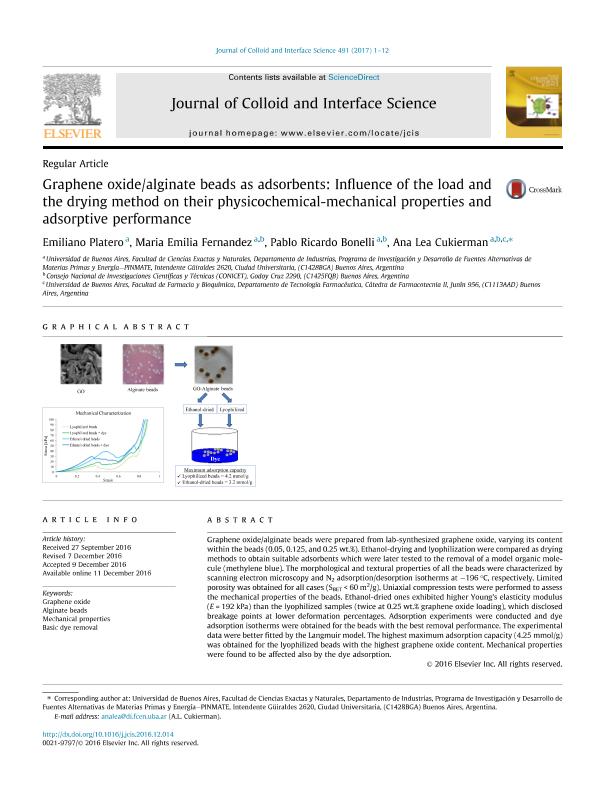Artículo
Graphene oxide/alginate beads as adsorbents: Influence of the load and the drying method on their physicochemical-mechanical properties and adsorptive performance
Fecha de publicación:
04/2017
Editorial:
Academic Press Inc Elsevier Science
Revista:
Journal of Colloid and Interface Science
ISSN:
0021-9797
Idioma:
Inglés
Tipo de recurso:
Artículo publicado
Clasificación temática:
Resumen
Graphene oxide/alginate beads were prepared from lab-synthesized graphene oxide, varying its content within the beads (0.05, 0.125, and 0.25 wt.%). Ethanol-drying and lyophilization were compared as drying methods to obtain suitable adsorbents which were later tested to the removal of a model organic molecule (methylene blue). The morphological and textural properties of all the beads were characterized by scanning electron microscopy and N2 adsorption/desorption isotherms at −196 °C, respectively. Limited porosity was obtained for all cases (SBET < 60 m2/g). Uniaxial compression tests were performed to assess the mechanical properties of the beads. Ethanol-dried ones exhibited higher Young's elasticity modulus (E = 192 kPa) than the lyophilized samples (twice at 0.25 wt.% graphene oxide loading), which disclosed breakage points at lower deformation percentages. Adsorption experiments were conducted and dye adsorption isotherms were obtained for the beads with the best removal performance. The experimental data were better fitted by the Langmuir model. The highest maximum adsorption capacity (4.25 mmol/g) was obtained for the lyophilized beads with the highest graphene oxide content. Mechanical properties were found to be affected also by the dye adsorption.
Palabras clave:
Alginate Beads
,
Basic Dye Removal
,
Graphene Oxide
,
Mechanical Properties
Archivos asociados
Licencia
Identificadores
Colecciones
Articulos(OCA CIUDAD UNIVERSITARIA)
Articulos de OFICINA DE COORDINACION ADMINISTRATIVA CIUDAD UNIVERSITARIA
Articulos de OFICINA DE COORDINACION ADMINISTRATIVA CIUDAD UNIVERSITARIA
Citación
Platero, Emiliano; Fernandez, Maria Emilia; Bonelli, Pablo Ricardo; Cukierman, Ana Lea; Graphene oxide/alginate beads as adsorbents: Influence of the load and the drying method on their physicochemical-mechanical properties and adsorptive performance; Academic Press Inc Elsevier Science; Journal of Colloid and Interface Science; 491; 4-2017; 1-12
Compartir
Altmétricas




